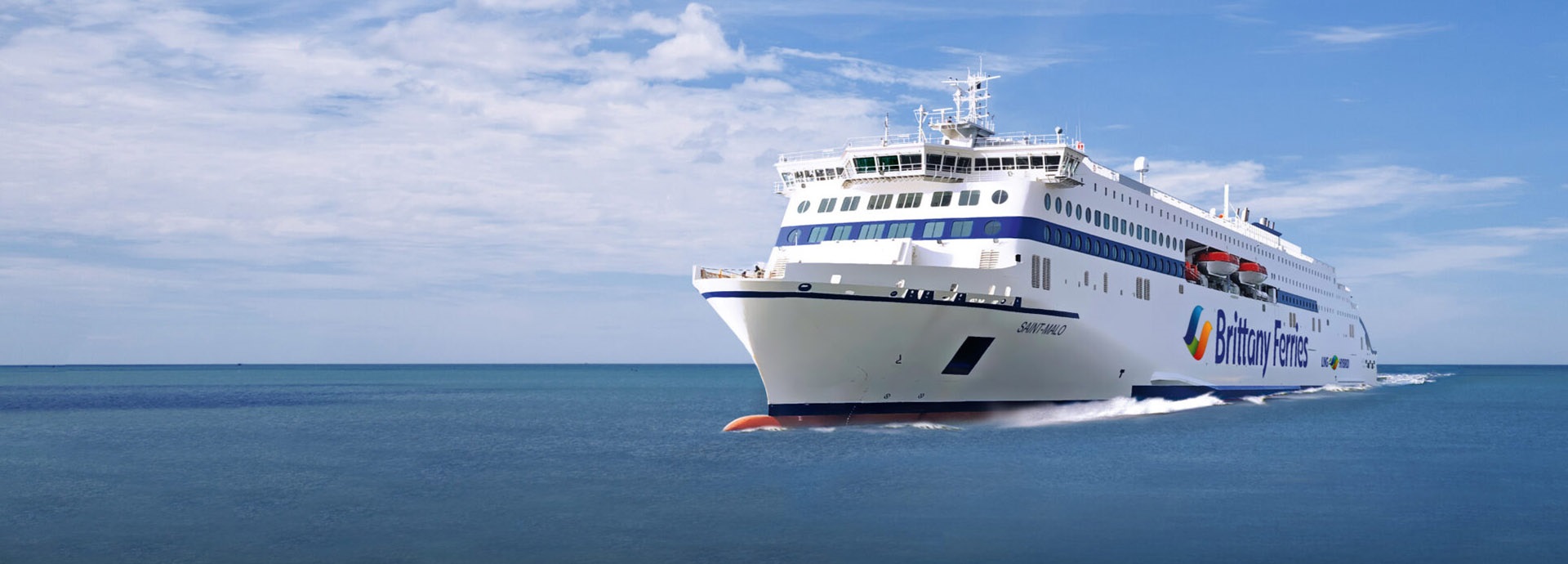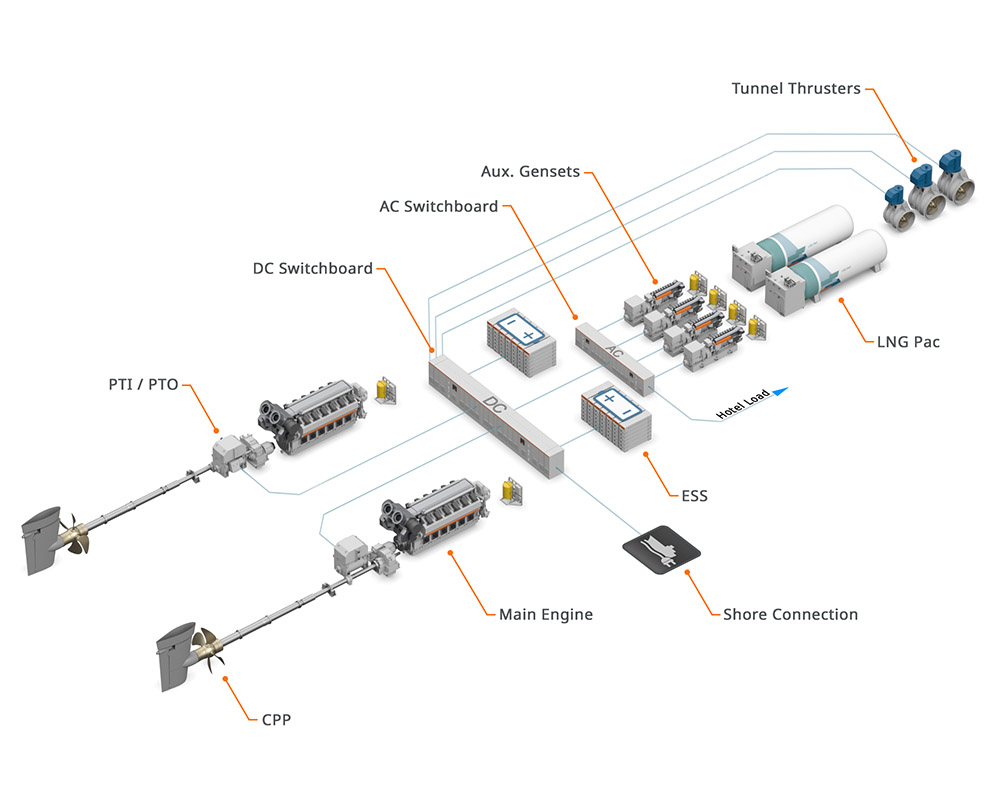

How is a hybrid power-up boosting Brittany Ferries’ drive to decarbonise?
How does it feel to sail onboard a record-breaking vessel with batteries big enough to keep the lights on in thousands of homes? If you travel with Brittany Ferries between the UK and France, you could soon be finding out. The vast 11.5 MWh energy storage system onboard two new hybrid RoPax vessels is making the phrase “batteries not included” a thing of the past – and cutting fuel consumption and emissions in the process.
The ferry industry is leading the charge in the effort to decarbonise shipping, and Brittany Ferries is firmly at the vanguard. Having already ordered two new LNG-powered ships in recent years – the Salamanca and Santoña, both Stena E-Flexer RoPax series vessels – the company has now taken another bold, battery-powered step forward.
In 2022 Brittany Ferries ordered two new hybrid vessels that will operate between Portsmouth in the UK and the French ports of Saint-Malo and Caen. Onboard will be a record-breaking 11.5 MWh battery-based energy storage system, making them the world’s largest hybrid vessels.
“The Salamanca and Santoña are tangible examples of Brittany Ferries’ long-term commitment to decarbonisation,” says Stefano De Marco, General Manager, SEAF Business Development & Decarbonisation Initiatives, Wartsila Marine Power. “Using LNG as fuel drastically reduces local sulphur oxide (SOx), nitrous oxide (NOx) and particulate matter (PM) emissions from shipping and also reduces carbon dioxide (CO2) emissions. With most passenger terminals located close to urban populations, LNG operation is therefore a significant step forward when it comes to cleaning up ferry operations.”
But Brittany ferries wanted to go further than just switching to a cleaner alternative fuel.
Why did Brittany Ferries choose a hybrid solution?
Hybrid operation is fast becoming the norm for newbuild ferries for two reasons. Firstly, it saves fuel and therefore emissions and OPEX. Secondly, it provides a great deal of operational flexibility for vessels.
The huge capacity of the energy storage system onboard the new vessels means that they will be able to enter, exit and manoeuvre around ports on clean battery power.
Brittany Ferries chose a hybrid system for its new vessels because they will be able to operate their engines at optimal load, which significantly improves efficiency. The batteries are used to absorb load fluctuations and provide power redundancy. They can also provide instantaneous power when needed, with no need to wait for auxiliary gensets to kick in.
“Brittany Ferries is proud to be taking a lead in sustainable shipping, working with our partners to bring cleaner vessels to the regions in which we operate,” says CEO Christophe Mathieu. “Hybrid technology continues to move our fleet renewal programme forward, and shore-side power capability means further benefits will be realised as investment by ports in plug-in infrastructure allows,” he continues.
“The huge capacity of the energy storage system onboard the new vessels means that they will be able to enter, exit and manoeuvre around ports on clean battery power. They will also be able to transit on battery power for part of the journey, although at restricted speeds,” says Philippe Mayet, Senior Account Manager, Wärtsilä Marine Power. “The battery-based system also provides peak shaving capability and backup to prevent power blackouts, adding an extra layer of redundancy for peace of mind.”
What’s inside the record-breaking hybrid system?
The Saint-Malo and her as-yet-unnamed sister ship have been designed and developed by Stena RoRo in collaboration with Brittany Ferries and will be chartered on a 10-year lease.
Wärtsilä is supplying a wide range of solutions for the vessels including:
- Wärtsilä 46DF dual-fuel engines and 20DF dual-fuel auxiliary gensets
- A selective catalytic reduction system (Wärtsilä NOx reducer)
- Seals and bearings
- Controllable pitch propellers
- Tunnel thrusters
- Wärtsilä LNGPac fuel gas supply system
- Navigation and propulsion control systems
- Wärtsilä HY hybrid/battery solution
- Long-term service agreement including Expert Insight digital predictive maintenance solution
To deliver its best, a hybrid system needs intelligent power management, and this is where Wärtsilä’s integration and optimisation expertise comes into play. “Smart energy management creates a system that’s greater than the sum of its parts,” says De Marco. “The hybrid system onboard the new ferries will be controlled and monitored using our intelligent energy management system (EMS). This is the ’brain’ that ensures all the elements work seamlessly together, optimising energy flows to achieve the best performance in all operational modes.”
When specifying and designing this kind of system, careful integration of all the different parts and optimising the system so that all the parts work together seamlessly is vital.

Hybrid system diagram for the SAINT-MALO & GUILLAUME DE NORMANDIE (in operation 2024/25)
Why is shore power so important to decarbonisation?
To maximise the benefits of their investment, Britany Ferries has also included a shore power connection on both vessels. This will eventually be used to charge the batteries while the vessels are berthed.
“A hybrid solution makes good sense even when gensets are used to charge the batteries, but it really pays off when they can be charged in port using renewable energy instead – without using fuel and generating emissions,” De Marco highlights. “Using shore power can have a positive influence on your vessel’s CII rating, which is based on grams of CO2 emitted per cargo-carrying capacity per nautical miles travelled. Emitting CO2 in port while the vessel is stationary harms your CII rating as it is not being offset by miles travelled. Using a shore power connection based on renewable energy eliminates these emissions.”
A hybrid solution makes good sense even when gensets are used to charge the batteries, but it really pays off when they can be charged in port using renewable energy instead.
As things stand, the biggest barrier to adopting shore power is the lack of infrastructure at ports. Vessel owners like Brittany Ferries are demonstrating a clear commitment to clean up their operations by investing in the technology; port authorities and their respective governments are also taking action at the quayside. Portsmouth, St. Malo and Caen all plan to have a shore power connection ready when the new vessels arrive or shortly after they begin operating. Portsmouth’s plans for shore power are part of its goal to become the UK’s first carbon-neutral port. The port authority is collaborating with the city council and electricity supplier SSE to install the solution.
“To maximise the decarbonisation potential of hybrid vessels, collaborating with the customer as early as possible in the process always delivers the best results,” Mayet remarks. “For ferry customers like Brittany Ferries electrification is clearly the key enabler to achieving their environmental goals.”
Want to learn more about how electrification and hybrid solutions can help you profitably decarbonise your ferry operations? Tune in to episode 5 of our Ferry Fireside chat series
Challenge
Minimise emissions and fuel consumption and maximise operational flexibility of two new LNG-fuelled RoPax vessels.
Solution
Wärtsilä hybrid propulsion system with battery-based energy storage, controlled by an intelligent energy management system.
Benefit
Vessels have huge operational flexibility, greatly reduced fuel consumption and emissions, and the ability to operate with zero emissions during manoeuvring operations and when in port.




